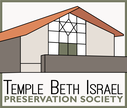Coming Home for the Holidays
We spent last year's HIgh Holidays in exile as our beloved, historic building was undergoing repairs. Our friends at the Federated Church of Christ in Brooklyn, CT generously let us use their chapel for our services. After rededicatng the Temple last October, we are now ready to come home for the holidays. Please circle these dates in your calendar and plan to join us for:
All are welcome.
- Rosh Hashanah: October 3
- Kol Nidre: October 11
- Yom Kippur: October 12
All are welcome.
© All Rights Reserved - Temple Beth Israel Preservation Society 2024
